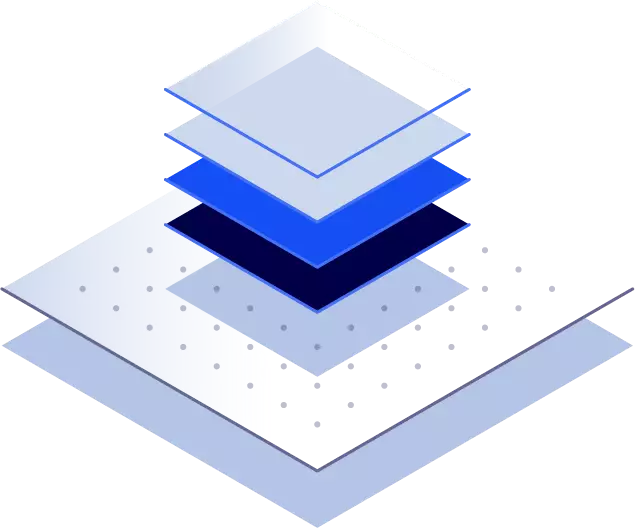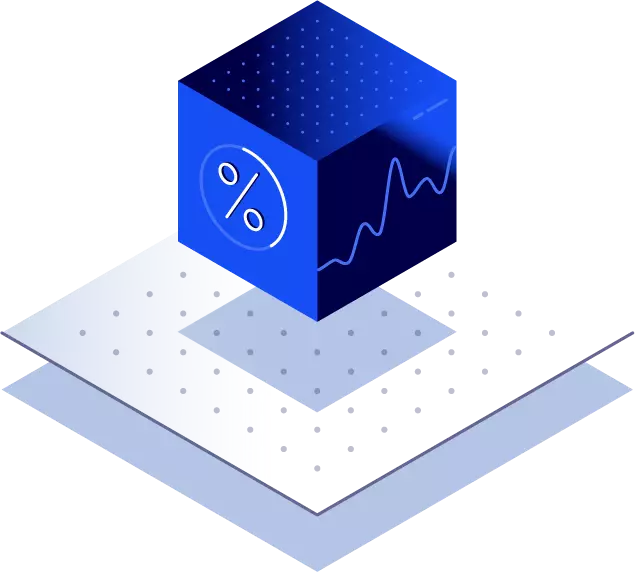Liquidity Flywheel Drives Binance to 300 Million Users

What’s Driving Bitcoin’s Rally?

Welcome to the Data Debrief!
Crypto markets are booming following a wave of ETF applications in the U.S., a welcome bullish catalyst in a much-battered region. This week, we explore:
-
TUSD’s soaring market share amid Prime Trust troubles.
-
The rising pace of delistings on exchanges.
-
Kraken’s resilient liquidity.
-
Binance market share on derivative markets.
Trend of the Week
Why is BTC rallying?
Bitcoin briefly hit yearly highs over the weekend and is up 15% week-on-week. What’s driving this rapid surge in prices? While news of a Blackrock ETF filing is certainly a bullish catalyst, let’s see what the data says.
BTC open interest recently hit its highest level since January, denominated in BTC, and one-year highs when denominated in dollars, suggesting rising inflows and speculation. This contributed to millions of short liquidations over the past seven days as prices pushed higher. ETH futures did not experience the same trend.
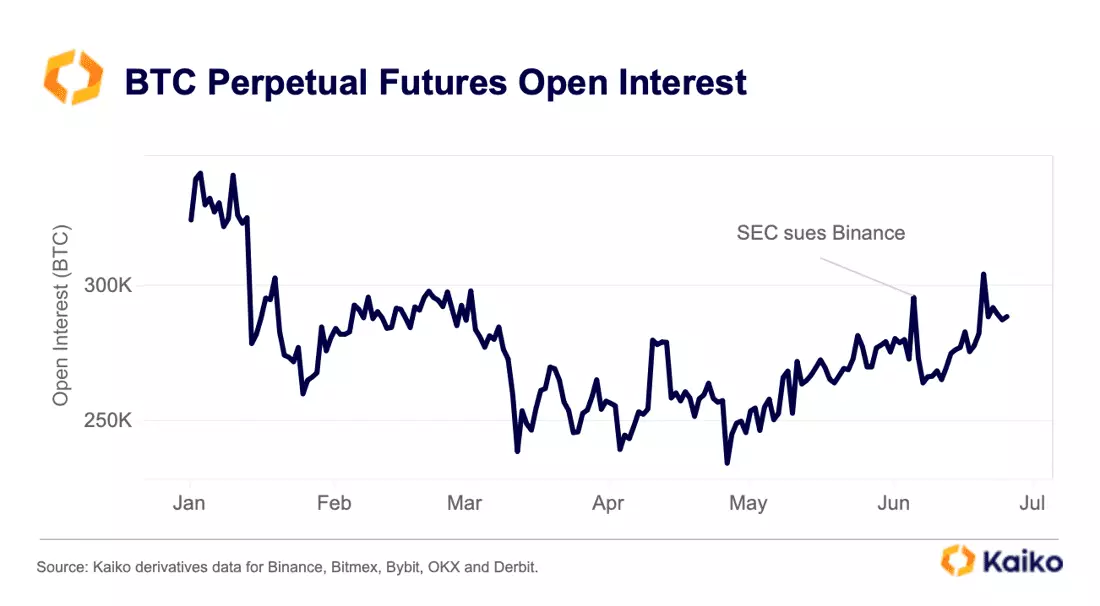
Yet, the rally does not seem to be decisively spot or derivatives-led when looking at volumes, as the spot to futures volume ratio has been mostly flat since March, which is when Binance halted most of its zero-fee BTC spot trading promotion.

In spot markets, we noticed that the ratio of Binance to Coinbase BTC volume has fallen significantly since the SEC lawsuit. These are the two highest volume exchanges in crypto and play a significant role in price discovery. As such, rising relative Coinbase volumes could suggest this exchange is leading spot market movements since the start of June.
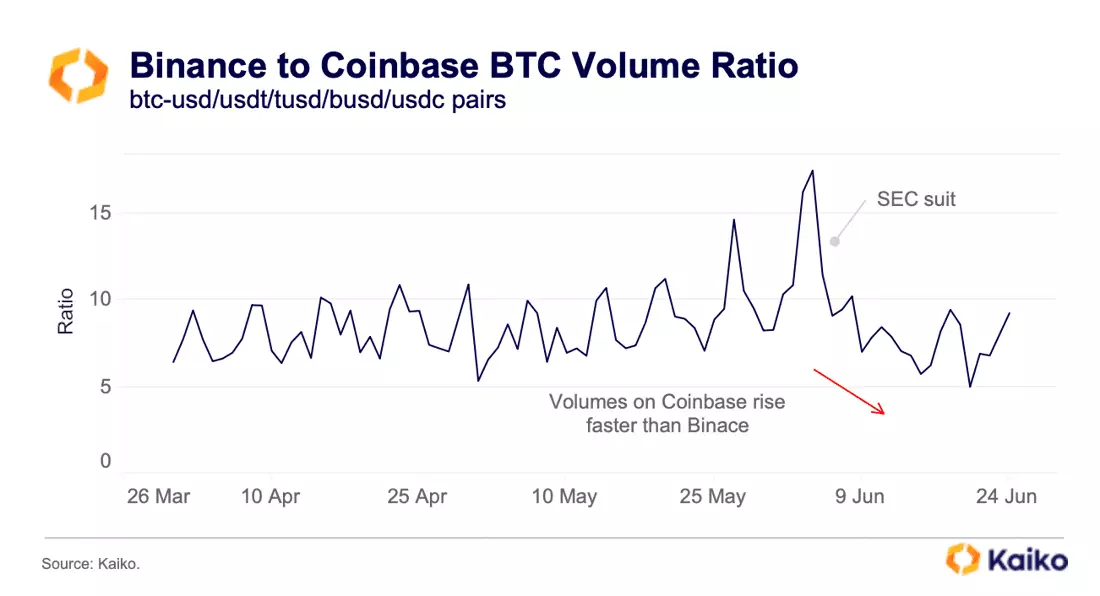
Diving further into the spot data, we can see that the ratio of BTC to altcoin volumes on U.S. exchanges is at nearly 50%. The Blackrock ETF news is particularly bullish for institutional U.S. investors, and the fact that relative BTC volumes are climbing suggests this rally is decisively BTC-led within U.S. markets. On offshore exchanges, BTC only accounts for 33% of market share.
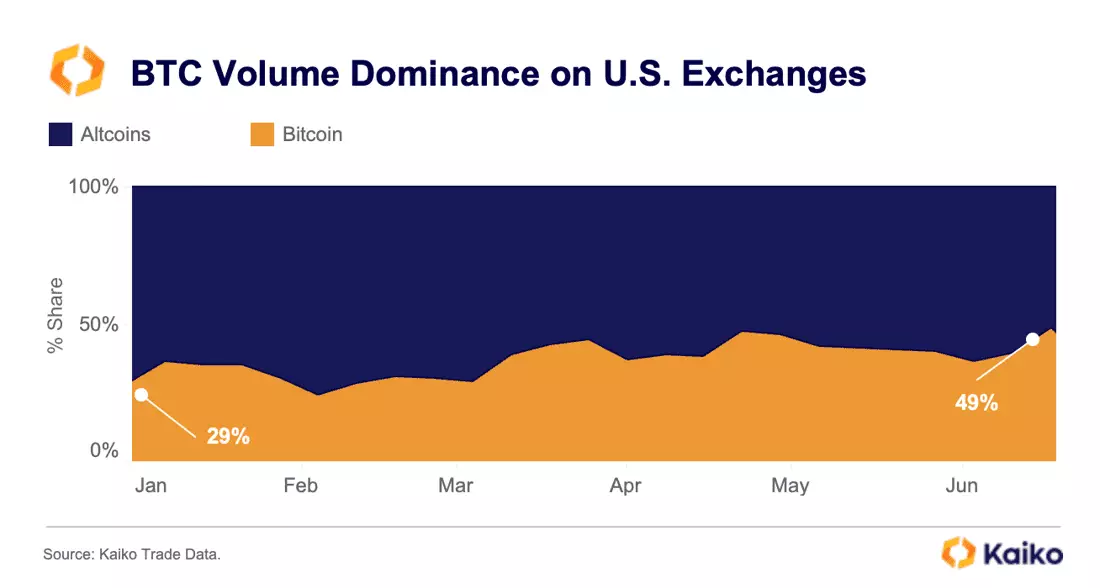
Overall, rising BTC open interest suggests derivatives markets are playing some role in the rally, with a concentration of spot market activity on U.S. markets.
Never miss an analysis.
Subscribe to our free weekly Data Debrief email, or learn more about our premium research subscriptions here.
Price
Stablecoin volatility is on the rise.
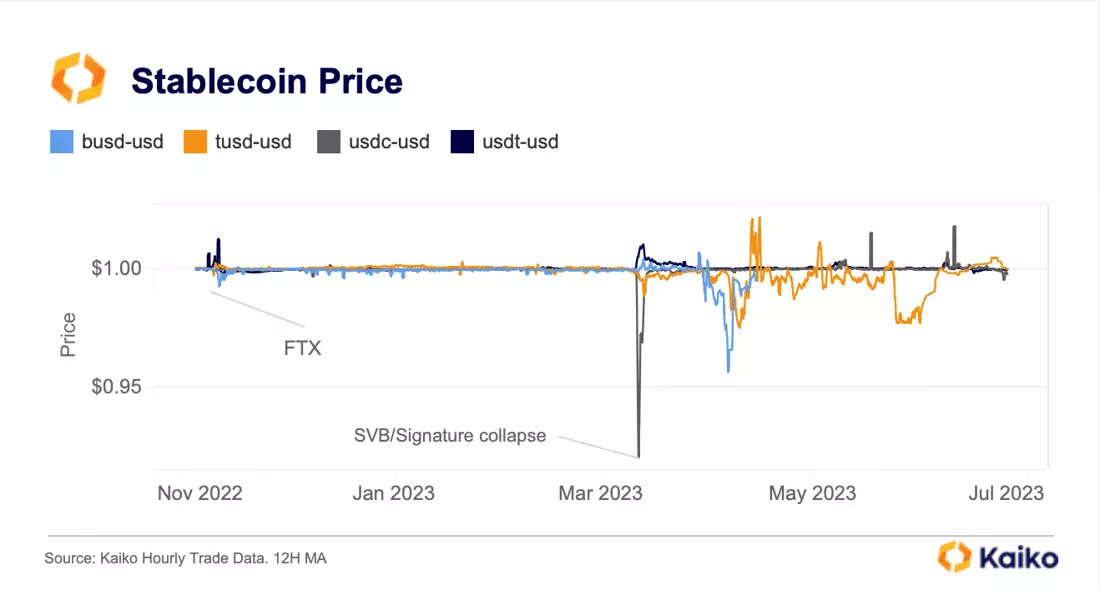
Stablecoin depegging events have become increasingly common in 2023. This trend has been mirrored by a decline of the combined market cap of the top five stablecoins, which has decreased by 5% YTD. While Tether’s USDT and TrueUSD’s TUSD have grown, reaching all-time highs in market cap, U.S.-regulated stablecoins like BUSD and USDC have witnessed significant outflows.
Amidst a staggering 272% increase in market cap, TUSD-USD pair volatility has surged the most, which can be attributed to its limited trading availability. TUSD only trades against the dollar on Bitfinex and CEX.IO. The TUSD-USDT price ratio has been more stable since Binance began promoting the stablecoin in March, but recently experienced volatility amid news that its technology partner, Prime Trust, halted mints.
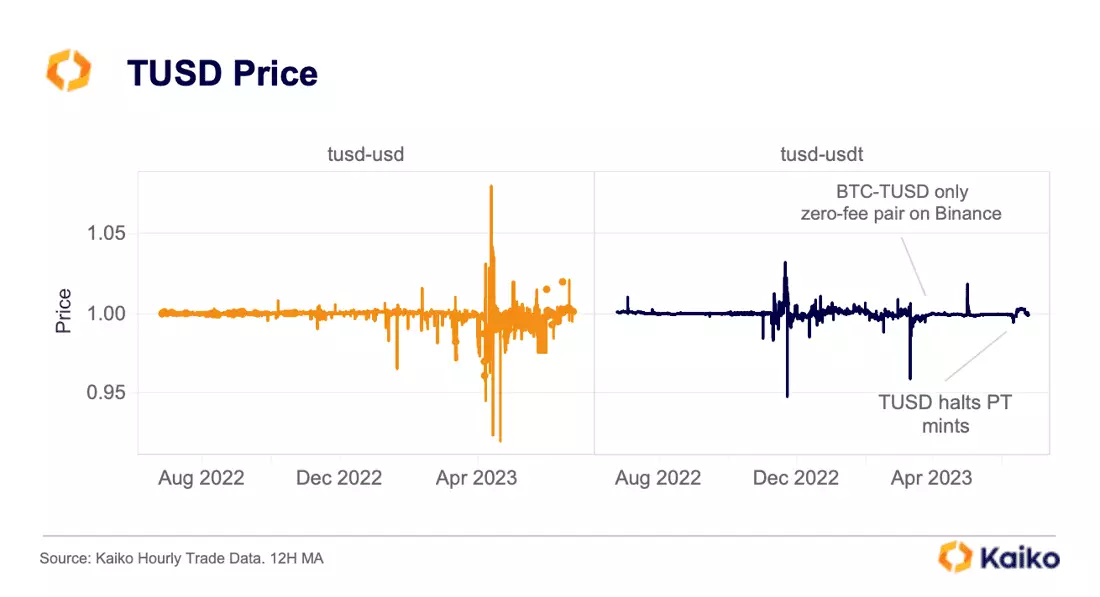
Stablecoin volatility is almost always linked to news around a specific stablecoin, such as when Circle halted USDC redemptions during the March banking crisis. However, volatility often overflows into other stablecoins via stablecoin trading pairs.
Liquidity
The number of delistings hits multi-year high.
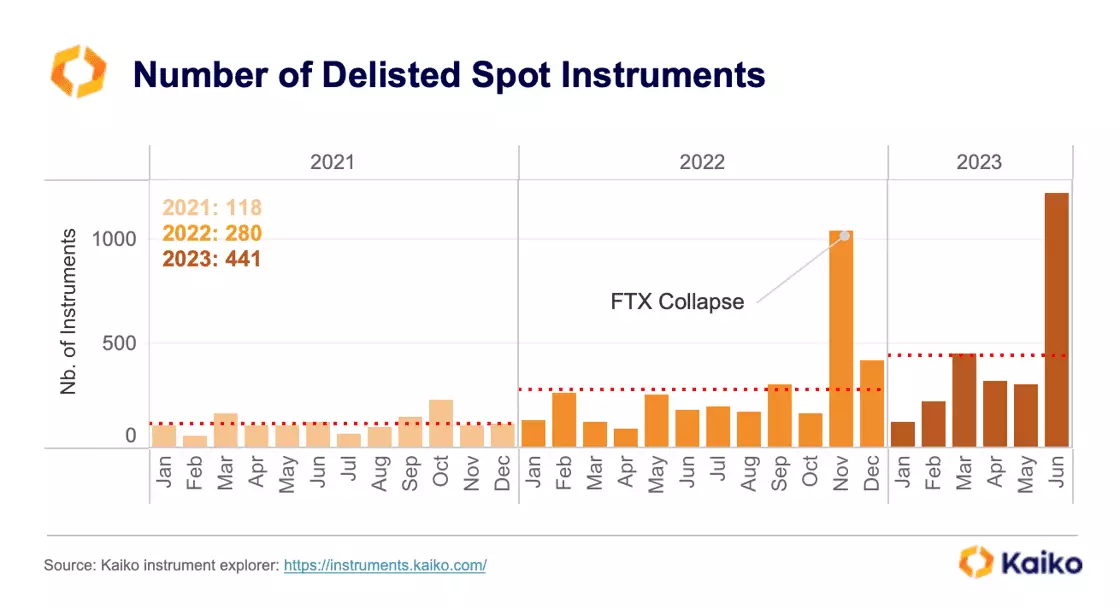
In June, the number of delisted spot instruments reached a multi-year high, surpassing the previous peak seen in November 2022 during the collapse of FTX and FTX.US. While delistings have been steadily increasing, with monthly figures doubling each year since 2021, the trend has significantly accelerated in 2023.
The majority of spot instruments were delisted from offshore exchanges, such as Huobi and HitBTC. However, the proportion of delistings on U.S.-based platforms has risen to 22% in 2023, up from 8% the previous year, primarily driven by Bittrex and Binance.US. Both exchanges have faced charges by the U.S. SEC for violating securities laws. Last week, Binance.US announced it would delist most USD pairs and transition to a crypto-only exchange.
The drop in global liquidity has also accelerated the pace of delistings. With less capital for market making, exchanges are opting to remove thinly traded instruments.
TUSD continues to soar despite redemption troubles.

TUSD has quickly become the second largest stablecoin by trade volume, surpassing BUSD just one month after Binance started promoting the stablecoin in March. This rapid surge is almost entirely driven by Binance’s zero-fee BTC-TUSD trading pair. Today, global TUSD-denominated trade volume accounts for 20% market share among other stablecoins, up from practically zero pre-Binance listing.
Yet, TUSD is facing a growing crisis of confidence after Prime Trust, a U.S.-based custodian, halted redemptions last week. The stablecoin claims to have no exposure, but this hasn’t stopped traders from shorting it.
Despite the surge in TUSD volumes, market depth has lagged, which suggests market makers are cautious to hold this high-risk stablecoin. Low liquidity poses a significant risk for the exchange in the event that TUSD loses its peg. The market depth for top altcoin pairs denominated by TUSD has decreased by nearly half in June compared to May, amounting to approximately $400k.
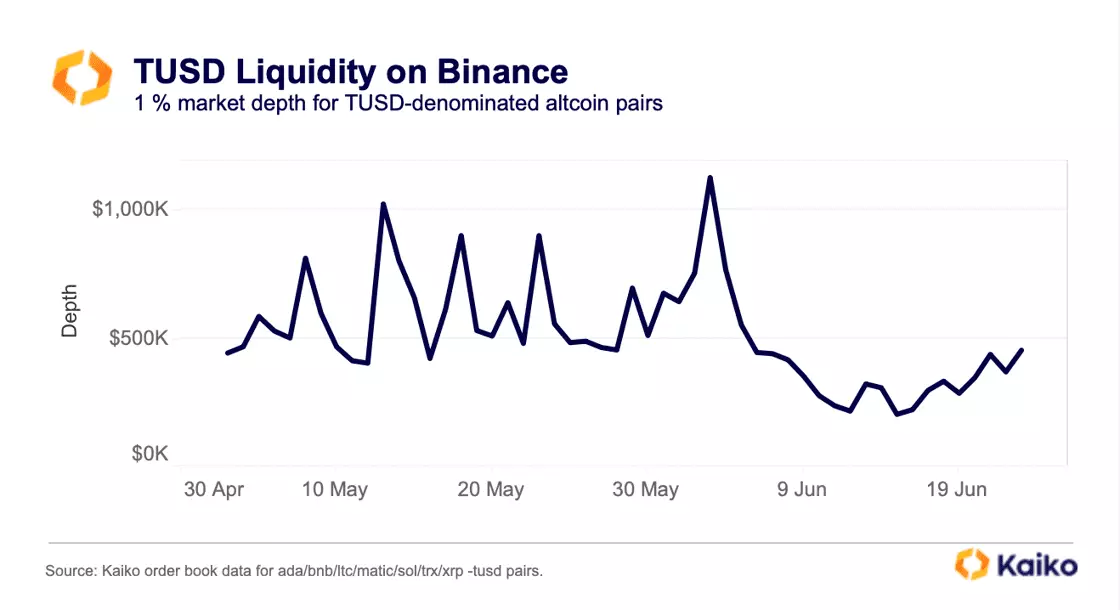
To enhance TUSD liquidity, Binance recently announced that it is expanding its TUSD maker zero-fee promotion to all TUSD pairs, a move designed to shore up low liquidity for altcoin markets. Daily trade volumes have surged, hitting as high as $11mn, almost 40 times the market depth, following the Prime Trust announcement on June 10.
Kraken bucks global liquidity trends.
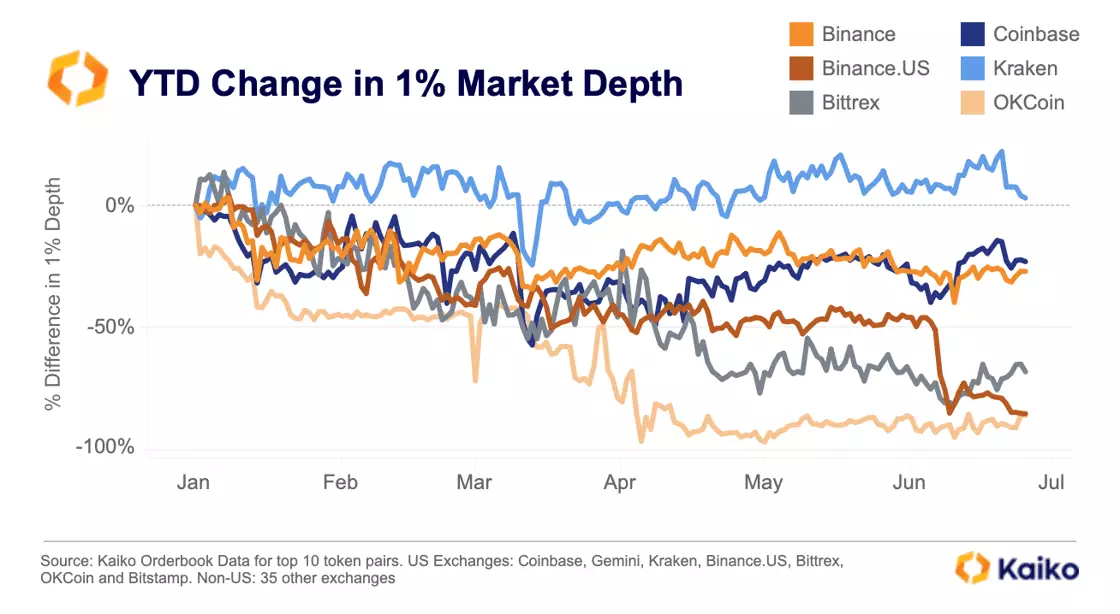
Kraken seems to be flying the flag for U.S. crypto liquidity. Kraken is the only exchange we cover that has increased its market depth since the start of the year. All other U.S.-available exchanges have experienced a sharp drop in liquidity.
Bittrex, Binance.US and OKCoin have seen their market depth drop the most for the top 10 tokens, with Bittrex depth down 68%, while Binance.US and OKCoin are both down 85% year to date. OKCoin suspended USD deposits after the banking crisis in March and Bittrex recently filed for bankruptcy. Kraken has largely avoided the regulatory crackdown, although it was forced to shutter its ETH staking service earlier this year.
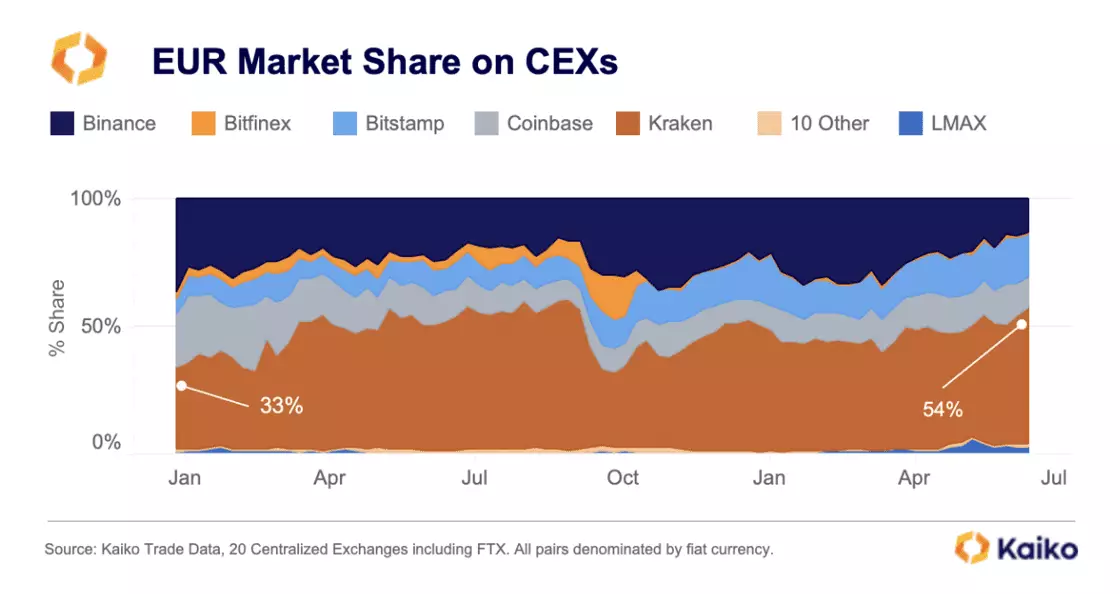
The good news continues for Kraken when zooming in on EUR market share of volumes, as it has improved its share from 33% to 54% this year. The increase in share for Kraken has largely been at the expense of Binance and Coinbase. Bitstamp has also seen a significant increase in its share of volumes.
stETH’s deposit share on Aave drops from all-time highs.
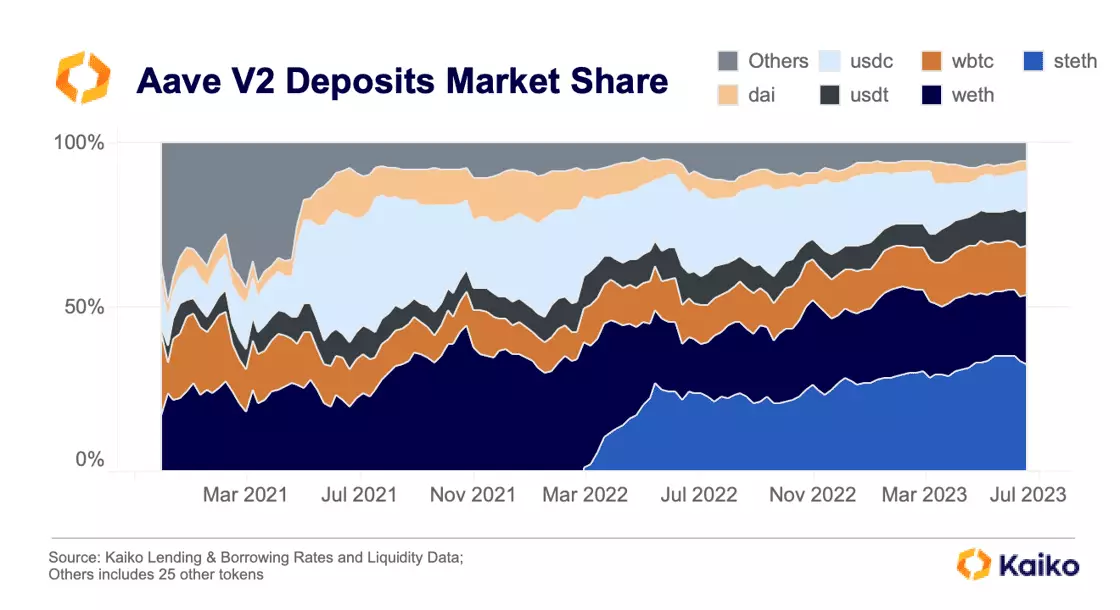
Within three months of being added to Aave V2, stETH became the most popular deposited asset, displacing wETH. Since September of last year, its share has steadily grown from 20% to 35% of total deposits. However, over the last two weeks, it has declined from its all-time high share of 35% to 32% as about 100k stETH have been removed from the protocol. Meanwhile, the Aave V3 protocol has been steadily growing, suggesting that the events of the past two weeks involving CRV (detailed in our latest Deep Dive) may have spurred some users to migrate from V2 to V3.
Asset Metrics:
The Ultimate Liquidity Toolkit
Asset Metrics provides information and liquidity metrics at the asset level. Aggregating data across all pairs and exchanges, this product gives you a global understanding of an asset’s market structure.
-
Trading activity: global volumes for thousands of instruments
-
Liquidity: market depth from .01% to 10% aggregated across order books
-
Addresses: distribution of an asset’s supply across a network
-
Coverage: all assets and exchanges covered by Kaiko
Derivatives
Binance market share drops to pre-FTX lows.
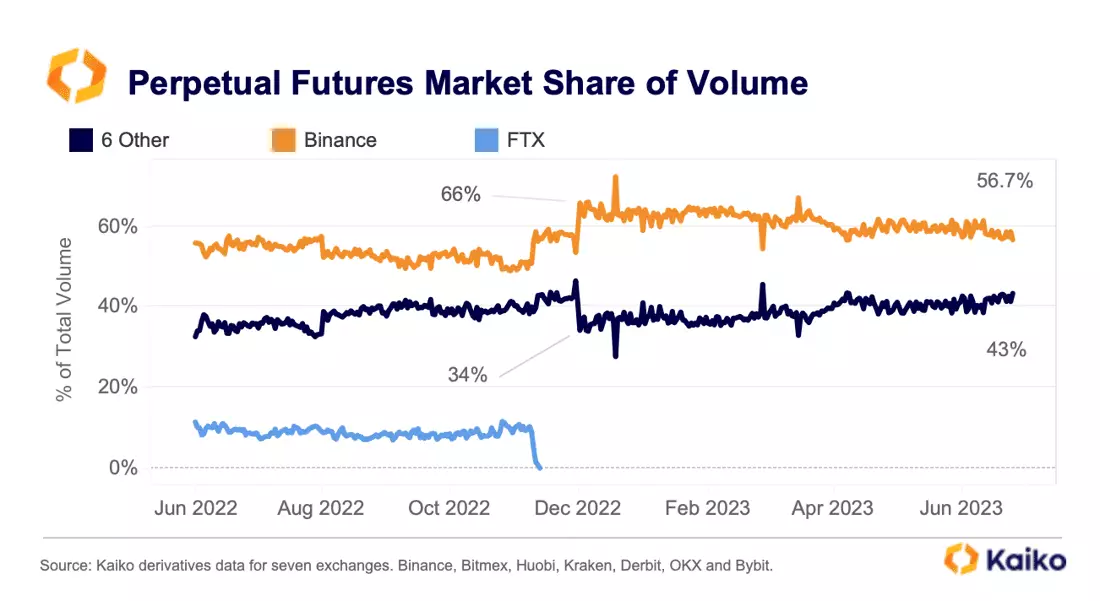
Binance’s share of perpetual futures volumes has been on a steady decline in 2023. Since the CFTC took up a case against Binance futures markets, the exchange has struggled to capture the same market share it did towards the end of last year. Starting the year at 66% of perpetual volumes, Binance has lost nearly 10% market share YTD, clocking in at 56.7% today. OKX was a big winner out of the ‘Other’ exchanges, with its market share up from 21% to 26% YTD.
Bitcoin dominance on perpetual futures markets rises.
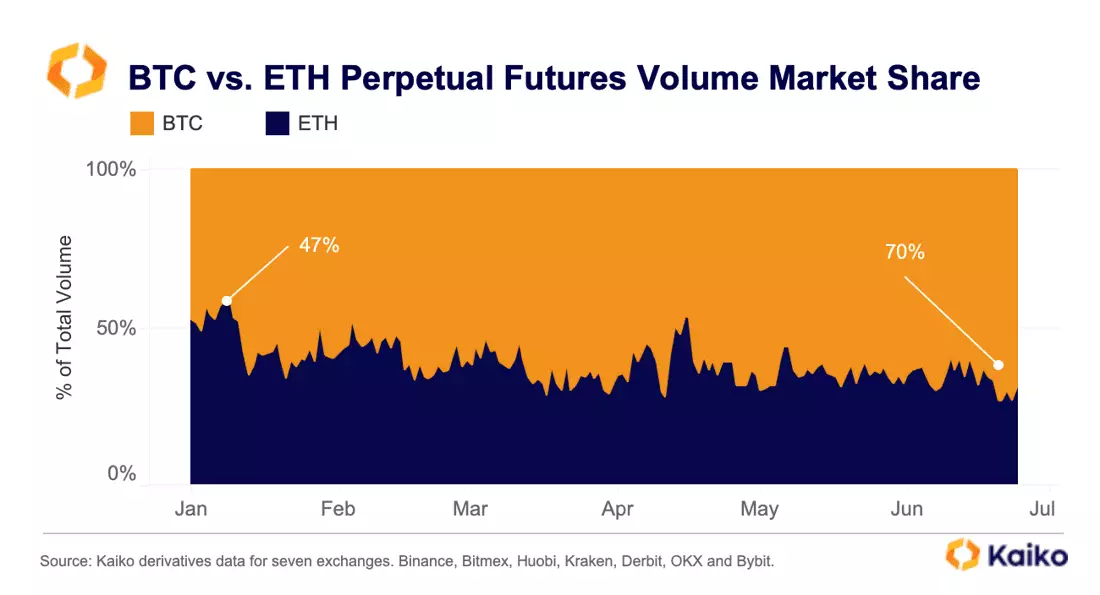
The share of BTC perpetual futures trade volumes aggregated on six exchanges hit 70% relative to ETH, its highest level since 2021. This is mirrored by rising BTC spot volume dominance. In contrast, capital inflows into ETH derivatives markets have slowed significantly since the Shanghai upgrade in April. The amount of open ETH openend futures contracts in native units (excluding price effect) has also fallen by more than 20% since the April highs.
Macro
GBTC outperforms BTC, shrinking discount.
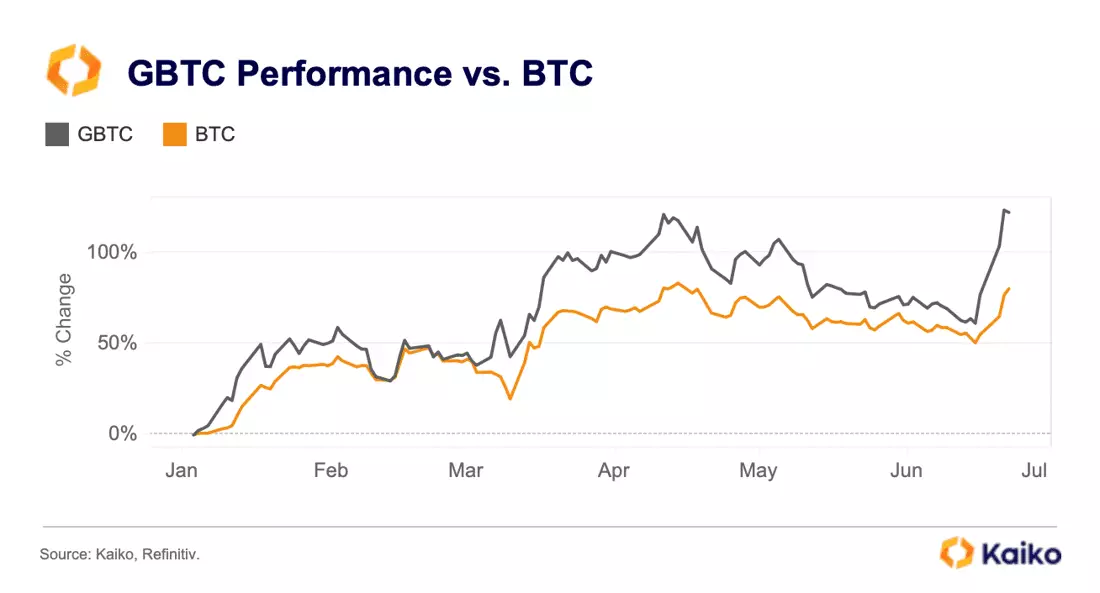
BTC had a good week, but GBTC’s was even better. Since the BlackRock ETF news, GBTC’s discount to BTC has fallen from nearly 45% to 33%. Amid a falling discount, GBTC has significantly outperformed BTC in year-to-date terms. Grayscale, the fund manager of GBTC, has been engaged in litigation with the SEC after the agency rejected its application to convert GBTC into an ETF. There hasn’t been much news on the case since March, when Grayscale’s CEO said he was encouraged by how their arguments were received by the judges.
While the proposed BlackRock ETF and GBTC aren’t directly linked, it’s clear that investors see BlackRock wading into the space as improving the odds GBTC will one day become an ETF.
Bitcoin’s correlation with Nasdaq plummets.
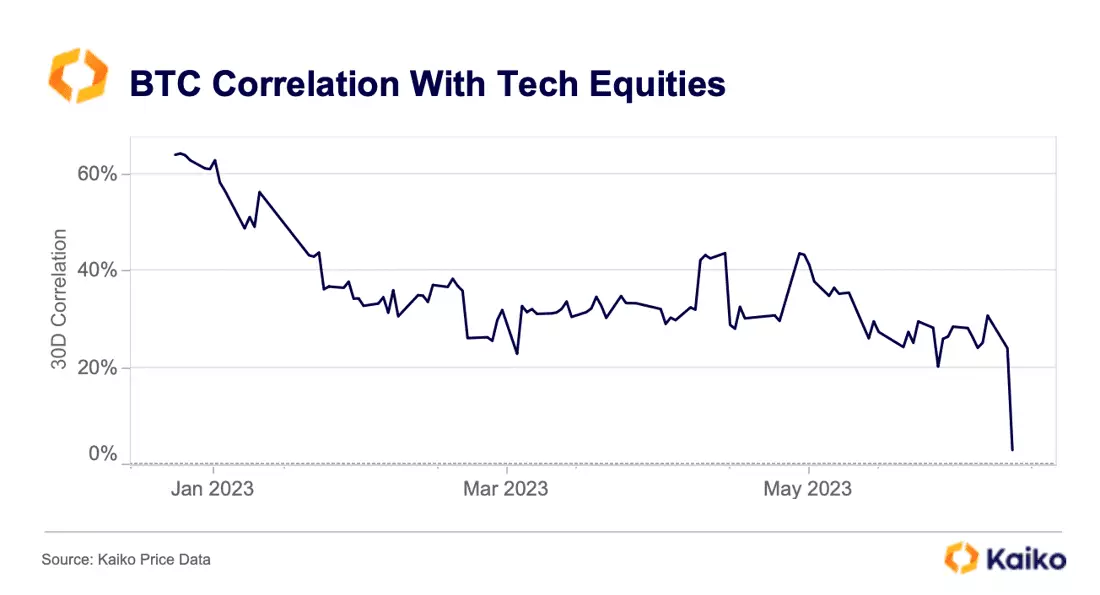
Bitcoin’s correlation with the tech-heavy Nasdaq 100 collapsed to just 3% in June, hitting its lowest level in nearly three years. Bitcoin outperformed tech equities this month jumping by nearly 14% while the Nasadq 100 is up only 3%. Overall, its correlation with traditional risk assets has steadily weakened this year from an average of 60% in 2022.

Data Used in this Analysis
Derivatives Metrics
![]()
Metrics and analytics products tailored to the cryptocurrency derivatives market.
Liquidity Metrics
![]()
The most granular order book data in the industry optimized for quantitative analyis.
Trade Volume
![]()
Centralized exchange data sourced from the most liquid venues, covering all traded instruments.
More From Kaiko Research
![]()
Derivatives
29/12/2025 Data Debrief
Santa Rallies, Cycles, and Year-End Reflections for BitcoinAs markets approach the end of the year, Bitcoin finds itself at a familiar crossroads, caught between cyclical behavior and a steadily developing market. While year-end seasonality has historically played a role in shaping price action, recent data suggests that cyclical drivers are increasingly dominant.
Written by Laurens Fraussen![]()
Derivatives
22/12/2025 Data Debrief
Crypto in 2026, What Breaks, What Scales, What ConsolidatesCrypto markets enter 2026 in a markedly different position than in prior cycle transitions. Rather than resetting after a speculative peak, the market appears to be progressing through a phase of institutional consolidation.
Written by Thomas Probst![]()
Year in Review
01/12/2025 Data Debrief
Kaiko Research's Top 10 Charts of 2025In this report, we look back on 2025 and the key forces that shaped markets. From BTC record highs and fleeting altcoin rallies to major liquidation events and evolving regulation, we examine what shaped a seminal year for crypto.Written by Adam Morgan McCarthy![]()
Stablecoin
24/11/2025 Data Debrief
MiCA's Impact on Crypto in EuropeEurope is progressing with a conservative structured crypto framework that leans towards regulating innovation.Written by Adam Morgan McCarthy


